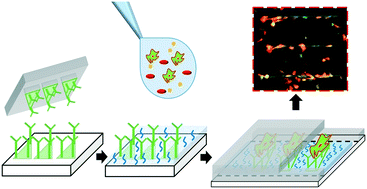Micropatterned biofunctional lubricant-infused surfaces promote selective localized cell adhesion and patterning†
Abstract
Micropatterned biofunctional surfaces provide a wide range of applications in bioengineering. A key characteristic which is sought in these types of bio-interfaces is prevention of non-specific adhesion for enhanced biofunctionality and targeted binding. Lubricant-infused omniphobic coatings have exhibited superior performance in attenuating non-specific adhesion; however, these coatings completely block the surfaces and do not support targeted adhesion or patterning. In this work, we introduce a novel lubricant-infused surface with biofunctional micropatterned domains integrated within an omniphobic layer. This new class of micropatterned lubricant-infused surfaces simultaneously promotes localized and directed binding of desired targets, as well as repellency of undesired species, especially in human whole blood. Furthermore, this modification method is easily translatable to microfluidic devices offering a wider range of applications and improved performance for immunoassays in whole blood and inhibition of clot formation in microfluidic channels. The biofunctional micropatterned lubricant-infused surfaces were created through a bench-top straight forward process by integrating microcontact printing, chemical vapor deposition (CVD) of self-assembled monolayers (SAMs) of fluorosilanes, and further infusion of the SAMs with a bio-compatible fluorocarbon-based lubricant layer. The developed surfaces, patterned with anti-CD34 antibodies, yield enhanced adhesion and controlled localized binding of target biomolecules (e.g. antibodies) and CD34 positive cells (e.g. HUVECs) inside microfluidic devices, outperforming conventional blocking methods (e.g. bovine serum albumin (BSA) or poly(ethylene glycol) (PEG)) in buffer and human whole blood. These surfaces offer a straightforward and effective way to enhance blocking capabilities while preserving the biofunctionality of a micropatterned system in complex biological environments such as whole blood. We anticipate that these micropatterned biofunctional interfaces will find a wide range of applications in microfluidic devices and biosensors for enhanced and localized targeted binding while preventing non-specific adhesion.



 Please wait while we load your content...
Please wait while we load your content...